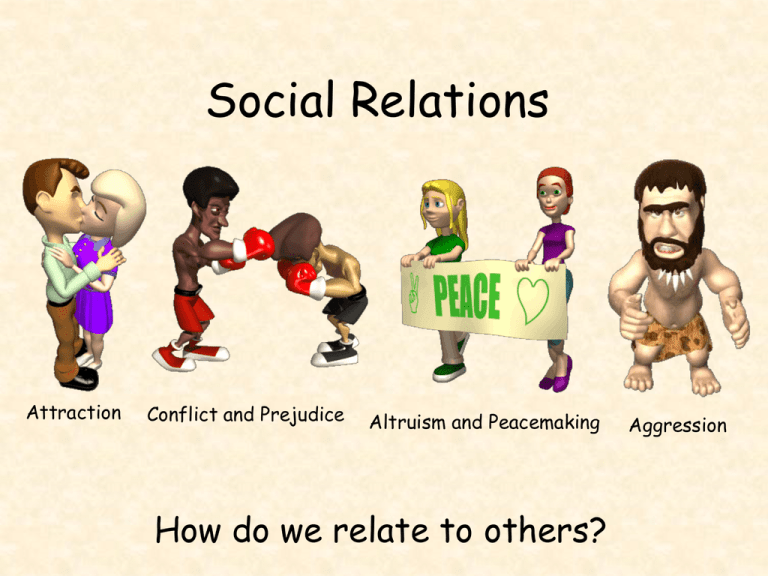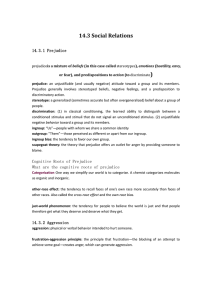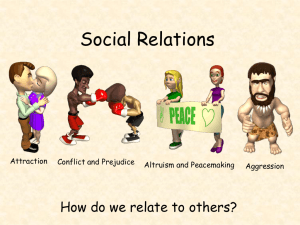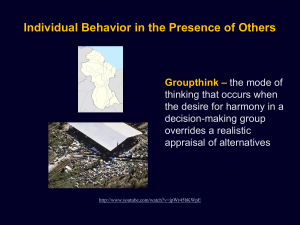Social Relations
advertisement

Social Relations Attraction Conflict and Prejudice Altruism and Peacemaking How do we relate to others? Aggression Prejudice How Prejudiced Are People? • Prejudice • Stereotype • Discrimination Prejudice Social Roots of Prejudice • Social Inequalities • Us and Them: Ingroup and Outgroup –Ingroup (Ingroup bias) –Outgroup • Emotional roots of prejudice –Scapegoat theory Social Inequalities (A principle reason behind prejudice) • Ingroup: “us”- people with whom one shares a common identity. • Outgroup: “them”those perceived as different than one’s ingroup. • Ingroup bias: the tendency to favor one’s own group. Scapegoat Theory • The theory that prejudice provides an outlet for anger by providing someone to blame. Prejudice Cognitive Roots of Prejudice • Categorization –Outgroup homogeneity –Other-race effect • Vivid cases (Availability Heuristic) • Just-world phenomenon –Hindsight bias Aggression • Any physical or verbal behavior intended to hurt or destroy. • In the U.S. we are MUCH more likely to be murdered compared to most other developed nations. The Biology of Aggression • Genetics • Neural Influences (is aggression in the brain) • Biochemical The Psychology of Aggression Frustration-Aggressive Principle: • the blocking of an attempt to achieve some goal • Creates anger which generates aggression. Goals can be: •Sports or work •Relationship •Body Condition etc… Hot Weather and Aggression Can we learn to be aggressive or gentle? They can be learned but…. Once learned they are difficult to change. Aggression and TV Watches = • By the time you are 18, you spend more time in front of TV than in school •2/3 of all homes have 3 or more sets average 51 hours a week. •By the time a child finishes elementary school they have witnessed 8000 murders and 100,000 other acts of violence on TV •Over half of all deaths do NOT show the victim's pain •As TV watching has grown exponentially, as does violent behavior- a strong positive correlation. •How do you think TV has effected sexual aggression? Biopsychosocial Understanding of Aggression Biopsychosocial Understanding of Aggression Biopsychosocial Understanding of Aggression Biopsychosocial Understanding of Aggression Conflict • A perceived incompatibility of actions, goals or ideas. • Social trap or prisoner's dilemma. Conflict and Peacemaking Enemy Perceptions • Mirror-image perceptions • Self-fulfilling prophecy Conflict and Peacemaking • Contact • Cooperation –Superordinate goals • Communication • Conciliation –GRIT Graduated and Reciprocated Initiatives in Tension-Reduction – a strategy designed to decrease international tensions. Attraction The Psychology of Attraction • Proximity –Mere exposure effect • Physical attractiveness • Similarity –Reward theory of attraction Attraction 5 Factors of Attraction…. Proximity Geographic nearness • Mere exposure effect: • Repeated exposure to something breeds liking. • Taiwanese Letters • Mirror image concept Reciprocal Liking • You are more likely to like someone who likes you. • Why? • Except in elementary school!!!! Similarity • Paula Abdul was wrong- opposites do NOT attract. • Birds of the same feather do flock together. • Similarity breeds content. Liking through Association • Classical Conditioning can play a pert in attraction. • I love Theo’s Wings. If I see the same waitress every time I go there, I may begin to associate that waitress with the good feelings I get from Theo's. Physical Attractiveness The Hotty Factor • Physically attractiveness predicts dating frequency (they date more). • They are perceived as healthier, happier, more honest and successful than less attractive counterparts. What is beauty? • Some people say beauty is facial symmetry. Beauty and Culture Are these cultures really that different? Attraction Romantic Love • Love –Passionate love –Companionate love • Equity • Self-disclosure Altruism • Altruism Unselfish regard for the welfare of others. –Kitty Genovese • Bystander Intervention –Diffusion of responsibility –Bystander effect Altruism Altruism Altruism Altruism Altruism Altruism Altruism Altruism Altruism Altruism The Norms of Helping • Social exchange theory The idea that our social behavior is an exchange process, which we maximize benefits and minimize costs. • Reciprocity norm • Social-responsibility norm Altruism • Unselfish regard for the welfare of others. • Kitty Genovese case. • Bystander Effect (bystanders less willing to help if there are other bystanders around).







